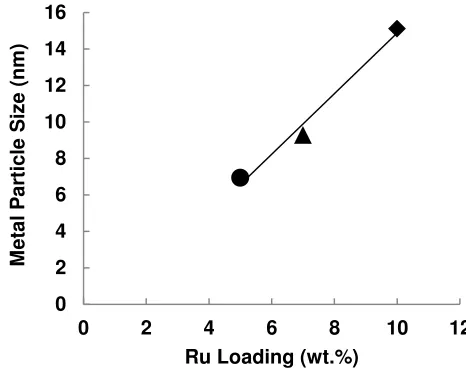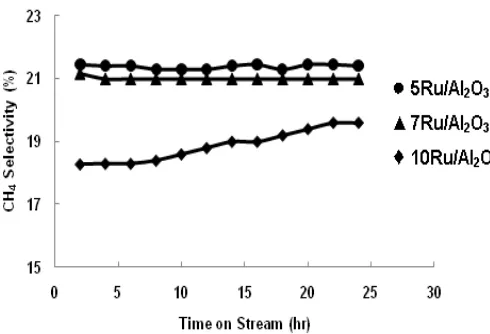136
ISBN 979-587-621-1
Effects of Ruthenium Loading on Carbon Monoxide Hydrogenation
Mardwita1*, Selpiana2, Elfidiah1, Ani Melani1, Netty Herawati1
1Chemical Engineering Department, Faculty of Engineering, Muhammadiyah
University of Palembang, 30263, Indonesia,
2Chemical Engineering Department, Faculty of Engineering, Sriwijaya University, Inderalaya, Indonesia
Abstract: Ruthenium-based catalysts have been found to be the effective catalysts for the catalytic of carbon monoxide hydrogenation. In this experiment, we investigated the effects of ruthenium loading on carbon monoxide hydrogenation. A series of supported ruthenium catalysts were prepared by conventional impregnation method. The reaction was performed at an atmospheric pressure and carried out at temperature of 220C. The reactant gas was consisted of hydrogen-carbon monoxide-argon. The flow rate of reactant gas was closed to 23 ml/min. The products were analyzed by gas chromatograph. Carbon monoxide chemisorptions, x-ray diffractometer were used to characterize the catalysts. The experiment results showed that carbon monoxide conversion was the highest for the catalyst contain 7 wt.% ruthenium loading. CH4 selectivity and olefin-to-paraffin ratio decreased with increasing
ruthenium loading, on the other hand, C5+ selectivity increased with increasing ruthenium loading. 7 wt.% ruthenium loading has a
metal size 9 nm, however the ruthenium metal was not detected in x-ray diffraction result.
Keywords: Carbon monoxide hydrogenation; Ruthenium catalyst; CO chemisorptions; X-ray difractometer; Noble metal 1
e-mail:wiwitdiita@gmail.com*
1. INTRODUCTION
Coal conversion process is an important reaction to generate energy due to the abundant source of coals which is estimated three times larger than oil reserve. The issue of energy crisis has been attracted due to the lack of energy source and the research on the possibility to utilize coal as the source of energy has grown faster and wide. Carbon monoxide (CO) hydrogenation is recognized as an alternative way to convert the coal gasifies gas or natural gas into higher hydrocarbon [1, 2]. The noble metal
catalysts are well-known for its high performance in catalytic reactions including in CO hydrogenation [3]. Ruthenium (Ru) is
one of the most active metals for CO hydrogenation and has been considered for the production of long chain hydrocarbons [4,5].
Metal dispersion in a catalyst plays an important role in catalytic reaction [6]. However, high dispersion of metal may not
be obtained due to the low ability of metal to disperse onto the support, preparation method, type of support, and etc. Ali. K et al investigated the reduction effects of ruthenium-promoted alumina supported cobalt (Co/Al2O3) catalyst in Fischer-Tropsch crystallite size [8, 9]. It is usually suggested that the metal content
in supported catalysts affects the catalytic activity or behavior of the catalysts. It is assumed that a high metal loading would increase the catalytic activity automatically, however, high metal content may result low metal dispersion, and this will decrease the catalytic activity. K. Murata et al investigated Fischer-Tropsch synthesis over supported ruthenium catalysts, the reactions were carried out in a slurry phase over supported ruthenium catalysts using hexadecane as a solvent. They found that the products were dependent on the oxide support, calcinations temperature, synthesis gas composition and sulfur content [10].
In this work, we prepared a series of ruthenium supported metal catalysts by the conventional impregnation method. To investigate the effects of ruthenium on carbon monoxide hydrogenation, we conducted the reaction on the lowest temperature and at an atmospheric pressure.
2. EXPERIMENTAL DETAILS
A. Catalysts Preparation
A series of supported ruthenium catalysts (Ru/Al2O3 in wt.%)
were prepared using conventional impregnation method. Gamma alumina powder (-Al2O3) (Aldrich Chemicals, UK) was used as
the support. The appropriate amount of an aqueous solution of ruthenium chloride hydrate (RuCl3xH2O) was impregnated into
-Al2O3. Water used as the solvent. The metal loaded powder was
evaporated at 80 C and dried overnight in an oven at 60 C. After drying, the solid was crushed, calcined at 375 C for 4 hours using air as the calcining gas and reduced by hydrogen and nitrogen at 375 C for 3.5 hours. The loading amount of Ru in the catalyst was 5 wt.%, 7 wt.%, and 10 wt.%. The catalysts were denoted as 5Ru/Al2O3, 7Ru/ Al2O3, and 10Ru/ Al2O3.
B. Catalysts Characterizations
The CO chemisorptions experiment for the determination of particle size was carried out by using BEL-CAT analyzer. In this characterization, 0.04 grams of catalyst was used and placed in a U-tube quartz reactor. Before adsorption of CO, the catalysts were preheated in He for 20 min at 300 oC, reduced for 60 min at
300 oC in a H2/Ar gas flow and in He for 5 min at 310 oC in a
reaction chamber. The samples were cooled down at 50 oC under
He gas flow. Finally, particle size of Ru was determined from CO pulse data. The metal surface area and dispersion of metal was characterized by the pulse technique.
X-ray diffraction (XRD) patterns were measured in a Rigaku, RINT 2000 diffractometer using Cu-Kα radiation and a scintillation detector. The crystallite size was obtained from the line width of the most intense reflections using the Scherrer equation.
C. Catalytic Activity
The CO hydrogenation was carried out at atmospheric pressure. The reactor used in this experiment was made of Pyrex glass. The reactor contained quartz wool onto which 0.1 grams catalyst was added. The reactor was externally heated by a furnace connected to the temperature controller. In-situ pretreatment of catalysts at 350 oC for 1 hour was done before
137
ISBN 979-587-621-1
the catalyst was closed to 23 ml/min. The reaction was performed at a temperature 220 oC. The products were analyzed by a gas amount of Ru added in the catalyst.
Fig.1. Effect of Ru Loading on CO Conversion
Although the CO conversion of 5Ru/Al2O3 catalyst was 12.8%, The number of active sites is determined by the Ru particle size, loading amount, and reduction degree.
The CO chemisorptions in Figure 2 shows the Ru crystalline size of Ru/Al2O3 catalysts, the particle size over 5Ru/Al2O3 and
7Ru/Al2O3 catalysts were 7 and 9 nm respectively, whereas
10Ru/Al2O3 catalyst showed about 15 nm particle size. This result
indicates that higher metal loading favorite to form large particle size of supported Ru. It was considered that 10Ru/Al2O3 catalyst
formed large Ru particle size and it might lead to lower Ru surface area, resulting in lower catalytic activity. In this experiment, high Ru loading did not contribute directly to the catalytic activity of Ru/Al2O3 catalyst.
Fig.2. Metal Particle Size over Ru Loading
Figure 3 shows the effect of Ru loading over Ru/Al2O3
catalysts with products selectivity and olefin-to-paraffin ratio. The results showed 5Ru/Al2O3 catalyst exhibited lower CO
conversion, C5+ selectivity and higher CH4 selectivity and
olefin-to-paraffin ratio than 7Ru/Al2O3 and 10Ru/Al2O3 catalysts. The
CH4 selectivity and olefin-to-paraffin ratio decreased in the order
138
ISBN 979-587-621-1
Fig.4. CO Hydrogenation Results with Time Dependence of CO Conversion over the Catalysts
Figures 5 and 6 show the reaction time dependence on CH4
and C5+ selectivity over Ru/Al2O3 catalysts for CO hydrogenation
at 220 C. In the case of 10Ru/Al2O3 catalyst, it showed slightly
increased in CH4 selectivity and decreased in C5+ selectivity with
time on stream, but these conditions were not observed over 5Ru/Al2O3 and 7Ru/Al2O3 catalysts. Olefin-to paraffin ratio time
dependence is shown in Figure 7, based on the results obtained, olefin-to-paraffin ratio was not affected by time on stream.
Fig.5. CO Hydrogenation Results with Time Dependence of CH4 Selectivity over the Catalysts
Fig.6. CO Hydrogenation Results with Time Dependence of CH5+ Selectivity over the Catalysts
Fig.7. CO Hydrogenation Results with Time Dependence of Olefin-to-Paraffin over the Catalysts
Figure 8 shows the XRD patterns of -Al2O3, 5Ru/ Al2O3,
7Ru/ Al2O3, and 10Ru/ Al2O3 catalysts.- Al2O3 shows as a
reference sample in this study. In this XRD patterns, all the catalysts showed similar diffraction peaks, however Ru species cannot be detected. It can be indicated that Ru species was highly dispersed on the catalyst surface [11].
Fig.8. X-ray Diffraction of the Catalysts
4. CONCLUSIONS
139
ISBN 979-587-621-1
exhibited higher CO conversion. The result indicates that higher metal loading favorite to form large particle size of supported Ru. High Ru loading did not contribute directly to the catalytic activity of Ru/Al2O3 catalyst.
REFERENCES
[1] A. P. Steybergm, M. E. Dry. Fischer-Tropsch technology. Stud. Surf. Sci. Catal.152 (2004)
[2] J. Schulz. Short history and present trends of Fischer-Tropsch synthesis. Appl. Catal. A. 182 (1999) 3-12.
[3] S. Ali, N. Asmawati M, Zabidi, D. Subbarao. Correlation between Fischer-Tropsch catalytic activity and composition of catalysts. J. Chem. Central. 5:68 (2011) 1-8.
[4] M. A. Vannice. The Catalytic synthesis of hydrocarbons from H2/CO mixture over the group VIII metals. J. Catal. 27
(1975) 449-461.
[5] F. King, E. Shutt, A. I. Thomson. Ruthenium catalyst systems for the production of hydrocarbons from coal. Platinum Metals Rev. 29 (4) (1985) 146-154.
[6] S. Bedrane, C. Descorme. An optimizes route for the preparation of well dispersed supported ruthenium catalysts. J. Mater. Chem. 12 (2002) 1563-1567.
[7] A. Karimi, A. N. Pour, F. Torabi, B. Hatami, A. Tavasoli, M. R. Alaei, M. Irani. Fischer-Tropsch synthesis over rutenium-promoted Co/Al2O3 catalyst with different reduction
procedures. J. of natural Gas Chemistry. 19 No.5 (2010) 503-508.
[8] C. H. Yang, J. G. Goodwin. Particle Size dependence for CO chemisorptions on supported Ru catalysts. React. Kinet. Catal. Lett. 20 (1982) 13-18.
[9] M. Nurunnabi, K. Murata, K. Okabe, M. Inaba, I. Takahara. Performance and characterization of Ru/Al2O3 and Ru/SiO2
catalysts modified with Mn for Fischer-Tropsch synthesis. Appl. Catal. A. 340 (2008) 203-211.
[10] K. Murata, K. Okabe, I. Takahara, M. Inaba, M. Saito. Fischer-Tropsch syntheis over Ru/Al2O3 catalysts. React.
Kinet. Catal. Lett. Vol 90. No. 2. (2007) 275-283.

